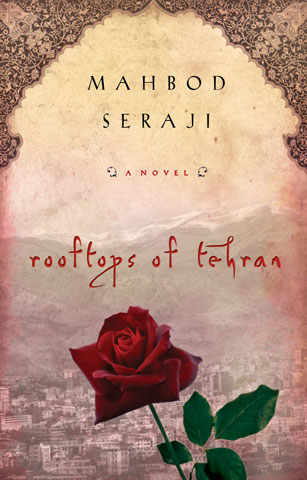“Rooftops of Tehran” inspires deeper thoughts on life, human struggles

Photo from “Rooftops of Tehran” official site, used with permission under fair use.
The rooftop wasn’t in Paris, Los Angeles or Barcelona. It wasn’t in London or Rome. The rooftop that Pasha and Ahmed contemplated their lives and loves on was in Tehran; quite unconventional for many American readers, yet it is the most familiar story to anyone regardless of heritage.
“Rooftops of Tehran” by Mahbod Seraji is a coming-of-age novel fraught with issues concerning love, friendship, trust, and relationships, only a few years shy of Iran’s 1979 revolution. Four people, Pasha, Ahmed, Zari, and Faheemeh all become friends over the summer of 1973. Ahmed and Faheemeh have a blatant relationship, yet must hide it from Faheemeh’s protective family. Pasha, however, is in love with Zari. Yet he cannot act upon that love because she has been betrothed from birth to a political science student everyone calls Doctor.
Doctor and Pasha are friends, which adds to the tension concerning love for Zari. But Pasha really admires Doctor because he’s a progressive thinker in a land where people insist upon following centuries’ old traditions. He is an activist who is sought by the SAVAK, the secret police that hunts down opposition to Shah Pahlavi’s regime, and eventually goes into hiding. The trust and bond built between all the friends, however, goes into jeopardy when Pasha accidentally reveals Doctor’s hiding place to the Shah’s secret police.
In the context of the main story, the little threads of vignettes surrounding it are beautifully composed by Seraji. The deeply rich characters profess various statements and anecdotes that readers can tie back into their own lives.
“This is a massive world, I think, and in each centimeter of it, a different drama unfolds every second of every day. But we live on as if the next moment in our lives will be no different than the last. How foolish we all are,” Pasha thinks while sitting on the roof of his house with Ahmed.
That’s one of the statements that, along with thinking about how universal that concept is, I feel a sensation in my heart that personally relates to it. I feel that way constantly while reading this book. It’s a hard feeling to explain, but it’s the kind I get when reading something profound, something that expands my mind’s horizons beyond anything that normally happens.
Comparisons to “The Kite Runner” by Khaled Hosseini are inevitable, and I feel like both books are equally compelling. Any novel with a significant social issue in the background of the characters is relatable to “Rooftops of Tehran,” and if one has an affinity for those kinds of books they will surely enjoy this one.
One significant thing about this book that stood out to me was the cover. There is a single red rose atop the rooftop setting in the background. A red rose is romantic; the characters are passionately in love, after all. Red is also the color of blood, a morbid metaphor for the revolution soon to take place. For the deaths and despair the characters eventually face, the rose signals it. The rose leads you to think before your eyes even trace the very first word on the very first page. This book is like pilates for your mind, and you will be a better person for reading it.
by KAVLEEN SINGH







![On the stage, Daniel Bozinovski and Rachel Treto play their part as Tom and Hannah in the show “The Cast List”. The show was about a group of students who were told about their cast list for the play “Romeo and Juliet.” The Theater I students were in preparation for their first showcase of the year. Students went over their lines during all of their class for the past two months. “[We put in] a lot of rehearsal, practicing lines, making sure you have everything memorized and making sure you are ready to go in and not forget anything,” Nathan Weeks said. Photo by Megan Kubas.](https://www.whitneyupdate.com/wp-content/uploads/2024/05/IMG_4085-600x396.jpg)
